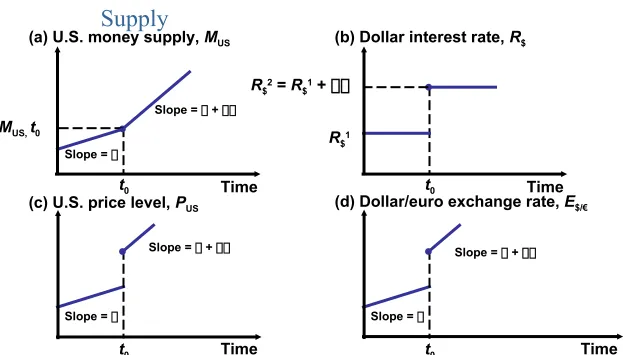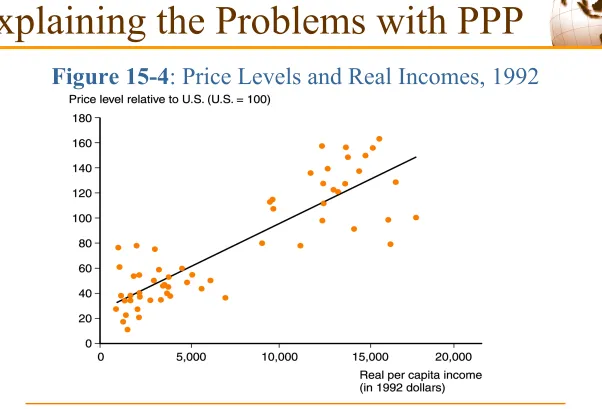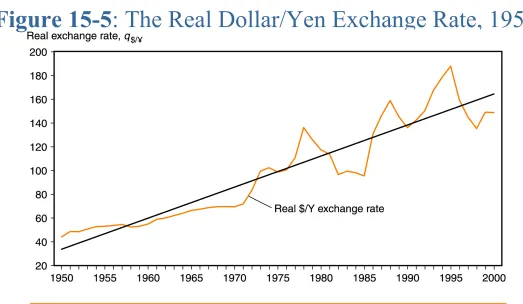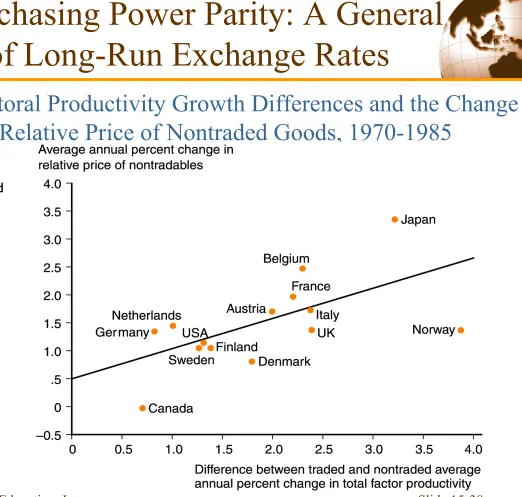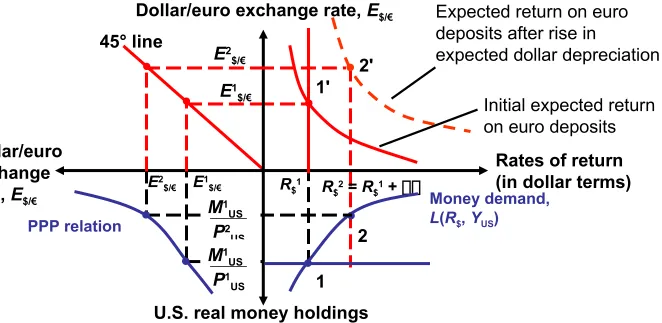Price Levels and the Exchange Rate in the Long Run
Price Levels and the Exchange Rate in the Long Run
Chapter 15
Chapter 15
Prepared by Iordanis Petsas
To Accompany
International Economics: Theory and Policy
International Economics: Theory and Policy, Sixth Edition
Slide 15-2 Copyright © 2003 Pearson Education, Inc.
Introduction
The Law of One Price
Purchasing Power Parity
A Long-Run Exchange Rate Model Based on PPP
Empirical Evidence on PPP and the Law of One Price
Explaining the Problems with PPP
Slide 15-3 Copyright © 2003 Pearson Education, Inc.
Beyond Purchasing Power Parity: A General Model
of Long-Run Exchange Rates
International Interest Rate Differences and the Real
Exchange Rate
Real Interest Parity
Summary
Appendix: The Fisher Effect, the Interest Rate, and
the Exchange Rate Under the Flexible-Price
Monetary Approach
Slide 15-4 Copyright © 2003 Pearson Education, Inc.
Introduction
The model of long-run exchange rate behavior
provides the framework that actors in asset markets
use to forecast future exchange rates.
Predictions about long-run movements in exchange
rates are important even in the short run.
In the long run, national price levels play a key role in
determining both interest rates and the relative prices
at which countries’ products are traded.
•
The theory of purchasing power parity (PPP)Slide 15-5 Copyright © 2003 Pearson Education, Inc.
The Law of One Price
Law of one price
•
Identical goods sold in different countries must sell for the same price when their prices are expressed in terms of the same currency.– This law applies only in competitive markets free of transport costs and official barriers to trade.
– Example: If the dollar/pound exchange rate is $1.50 per
Slide 15-6 Copyright © 2003 Pearson Education, Inc.
– It implies that the dollar price of good i is the same wherever it is sold:
PiUS = (E$/€) x (PiE)
where:
PiUS is the dollar price of good i when sold in the U.S.
PiE is the corresponding euro price in Europe
E$/€ is the dollar/euro exchange rate
Slide 15-7 Copyright © 2003 Pearson Education, Inc.
Purchasing Power Parity
Theory of Purchasing Power Parity (PPP)
•
The exchange rate between two counties’ currencies equals the ratio of the counties’ price levels.•
It compares average prices across countries.•
It predicts a dollar/euro exchange rate of:E$/€ = PUS/PE (15-1)
where:
PUS is the dollar price of a reference commodity
basket sold in the United States
Slide 15-8 Copyright © 2003 Pearson Education, Inc.
Purchasing Power Parity
By rearranging Equation (15-1), one can obtain:
P
US= (
E
$/€)
x
(
P
E)
Slide 15-9 Copyright © 2003 Pearson Education, Inc.
The Relationship Between PPP and the Law of One
Price
•
The law of one price applies to individualcommodities, while PPP applies to the general price level.
•
If the law of one price holds true for every commodity, PPP must hold automatically for the same reference baskets across countries.•
Proponents of the PPP theory argue that its validity does not require the law of one price to hold exactly.Slide 15-10 Copyright © 2003 Pearson Education, Inc.
Absolute PPP and Relative PPP
•
Absolute PPP– It states that exchange rates equal relative price levels.
•
Relative PPP– It states that the percentage change in the exchange rate between two currencies over any period equals the
difference between the percentage changes in national price levels.
– Relative PPP between the United States and Europe would be:
(E$/€,t - E$/€, t –1)/E$/€, t –1 = US, t - E, t (15-2)
where:
t = inflation rate
Slide 15-11 Copyright © 2003 Pearson Education, Inc.
Monetary approach to the exchange rate
•
A theory of how exchange rates and monetary factors interact in the long run.
The Fundamental Equation of the Monetary
Approach
•
Price levels can be expressed in terms of domestic money demand and supplies:– In the United States:
PUS = MsUS/L (R$, YUS) (15-3)
– In Europe:
PE = MsE/L (R€, YE) (15-4)
Slide 15-12 Copyright © 2003 Pearson Education, Inc.
•
The monetary approach makes a number of specific predictions about the long-run effects on the exchange rate of changes in:– Money supplies
– An increase in the U.S. (European) money supply causes a proportional long-run depreciation (appreciation) of the dollar against the euro.
– Interest rates
– A rise in the interest rate on dollar (euro) denominated assets causes a depreciation (appreciation) of the dollar against the euro.
– Output levels
– A rise in U.S. (European) output causes an appreciation (depreciation) of the dollar against the euro.
Slide 15-13 Copyright © 2003 Pearson Education, Inc.
Ongoing Inflation, Interest Parity, and PPP
•
Money supply growth at a constant rate eventuallyresults in ongoing inflation (i.e., continuing rise in the price level) at the same rate.
– Changes in this long-run inflation rate do not affect the full-employment output level or the long-run relative prices of goods and services.
•
The interest rate is not independent of the money supply growth rate in the long run.Slide 15-14 Copyright © 2003 Pearson Education, Inc.
•
The international interest rate difference is the
difference between expected national inflation
rates:
R$ - R€ = eUS- e (15-5)
Slide 15-15 Copyright © 2003 Pearson Education, Inc.
The Fisher Effect
•
A rise (fall) in a country’s expected inflation rate will eventually cause an equal rise (fall) in the interest rate that deposits of its currency offer.– Figure 15-1 illustrates an example, where at time t0 the
Federal Reserve unexpectedly increases the growth rate of the U.S. money supply to a higher level.
Slide 15-16 Copyright © 2003 Pearson Education, Inc.
Slope = +
Figure 15-1: Long-Run Time Paths of U.S. Economic Variables after a Permanent Increase in the Growth Rate of the U.S. Money Supply
(d) Dollar/euro exchange rate, E$/€
Time (b) Dollar interest rate, R$
Time (c) U.S. price level, PUS
Time
Slide 15-17 Copyright © 2003 Pearson Education, Inc.
•
In this example, the dollar interest rate rises because people expect more rapid future money supply growth and dollar depreciation.•
The interest rate increase is associated with higher expected inflation and an immediate currencydepreciation.
•
Figure 15-2 confirms the main long-run prediction of the Fisher effect.Slide 15-18 Copyright © 2003 Pearson Education, Inc.
Figure 15-2: Inflation and Interest Rates in Switzerland, the United States, and Italy, 1970-2000
Slide 15-19 Copyright © 2003 Pearson Education, Inc.
Figure 15-2: Continued
A Long-Run Exchange Rate
Model Based on PPP
Slide 15-20 Copyright © 2003 Pearson Education, Inc.
A Long-Run Exchange Rate
Model Based on PPP
Slide 15-21 Copyright © 2003 Pearson Education, Inc.
The empirical support for PPP and the law of one
price is weak in recent data.
•
The prices of identical commodity baskets, when converted to a single currency, differ substantially across countries.•
Relative PPP is sometimes a reasonable approximation to the data, but it performs poorly.Slide 15-22 Copyright © 2003 Pearson Education, Inc.
Empirical Evidence on PPP
and the Law of One Price
Slide 15-23 Copyright © 2003 Pearson Education, Inc.
The failure of the empirical evidence to support the
PPP and the law of one price is related to:
•
Trade barriers and nontradables•
Departures from free competition•
International differences in price level measurementSlide 15-24 Copyright © 2003 Pearson Education, Inc.
Trade Barriers and Nontradables
•
Transport costs and governmental trade restrictions make trade expensive and in some cases createnontradable goods.
– The greater the transport costs, the greater the range over which the exchange rate can move.
Slide 15-25 Copyright © 2003 Pearson Education, Inc.
Departures from Free Competition
•
When trade barriers and imperfectly competitive market structures occur together, linkages between national price levels are weakened further.•
Pricing to market– When a firm sells the same product for different prices
in different markets.
– It reflects different demand conditions in different countries.
– Example: Countries where demand is more price-inelastic will tend to be charged higher markups over a monopolistic seller’s production cost.
Slide 15-26 Copyright © 2003 Pearson Education, Inc.
International Differences in Price Level Measurement
•
Government measures of the price level differ from country to country because people living in different counties spend their income in different ways.
PPP in the Short Run and in the Long Run
•
Departures from PPP may be even greater in the short- run than in the long run.– Example: An abrupt depreciation of the dollar against foreign currencies causes the price of farm equipment in the U.S. to differ from that of foreign’s until markets
adjust to the exchange rate change.
Slide 15-27 Copyright © 2003 Pearson Education, Inc.
Explaining the Problems with PPP
Slide 15-28 Copyright © 2003 Pearson Education, Inc.
The Real Exchange Rate
•
It is a broad summary measure of the prices of one country’s goods and services relative to the other's.•
It is defined in terms of nominal exchange rates and price levels.•
The real dollar/euro exchange rate is the dollar price of the European basket relative to that of the American:q$/€ = (E$/€ x PE)/PUS (15-6)
– Example: If the European reference commodity basket costs €100, the U.S. basket costs $120, and the nominal exchange rate is $1.20 per euro, then the real dollar/euro exchange rate is 1 U.S. basket per European basket.
Slide 15-29 Copyright © 2003 Pearson Education, Inc.
•
Real depreciation of the dollar against the euro– A rise in the real dollar/euro exchange rate
– That is, a fall in the purchasing power of a dollar within Europe’s borders relative to its purchasing power within the United States
– Or alternatively, a fall in the purchasing power of America’s products in general over Europe’s.
•
A real appreciation of the dollar against the euro is the opposite of a real depreciation.Slide 15-30 Copyright © 2003 Pearson Education, Inc.
Demand, Supply, and the Long-Run Real Exchange
Rate
•
In a world where PPP does not hold, the long-run values of real exchange rates depend on demand and supplyconditions.
Slide 15-31 Copyright © 2003 Pearson Education, Inc.
•
There are two specific causes that explain why the long-run values of real exchange rates can change:– A change in world relative demand for American products
– An increase (fall) in world relative demand for U.S. output causes a long-run real appreciation (depreciation) of the dollar against the euro.
– A change in relative output supply
– A relative expansion of U.S (European) output causes a long-run real depreciation (appreciation) of the dollar against the euro.
Slide 15-32 Copyright © 2003 Pearson Education, Inc.
Nominal and Real Exchange Rates in Long-Run
Equilibrium
•
Changes in national money supplies and demands give rise to the proportional long-run movements innominal exchange rates and international price level ratios predicted by the relative PPP theory.
•
From Equation (15-6), one can obtain the nominaldollar/euro exchange rate, which is the real dollar/euro exchange rate times the U.S.-Europe price level ratio:
E $/€ = q$/€ x (PUS/PE) (15-7)
Slide 15-33 Copyright © 2003 Pearson Education, Inc.
•
Equation (15-7) implies that for a given realdollar/euro exchange rate, changes in money demand or supply in Europe or the U.S. affect the long-run nominal dollar/euro exchange rate as in the monetary approach.
– Changes in the long-run real exchange rate, however,
also affect the long-run nominal exchange rate.
Slide 15-34 Copyright © 2003 Pearson Education, Inc.
The most important determinants of long-run swings
in nominal exchange rates (assuming that all
variables start out at their long-run levels):
•
A shift in relative money supply levels•
A shift in relative money supply growth rates•
A change in relative output demand•
A change in relative output supplySlide 15-35 Copyright © 2003 Pearson Education, Inc.
When all disturbances are monetary in nature,
exchange rates obey relative PPP in the long run.
•
In the long run, a monetary disturbance affects only the general purchasing power of a currency.– This change in purchasing power changes equally the currency’s value in terms of domestic and foreign
goods.
•
When disturbances occur in output markets, theexchange rate is unlikely to obey relative PPP, even in the long run.
Slide 15-36 Copyright © 2003 Pearson Education, Inc.
Beyond Purchasing Power Parity: A General
Model of Long-Run Exchange Rates
Slide 15-37 Copyright © 2003 Pearson Education, Inc.
Beyond Purchasing Power Parity: A General
Model of Long-Run Exchange Rates
Slide 15-38 Copyright © 2003 Pearson Education, Inc.
Figure 15-6: Sectoral Productivity Growth Differences and the Change in the Relative Price of Nontraded Goods, 1970-1985
Slide 15-39 Copyright © 2003 Pearson Education, Inc.
In general, interest rate differences between countries
depend not only on differences in expected inflation,
but also on expected changes in the real exchange
rate.
Relationship between the
expected
change in the real
exchange rate, the
expected
change in the nominal
rate, and
expected
inflation:
(
q
e$/€-
q
$/€)/
q
$/€= [(
E
e$/€-
E
$/€)/
E
$/€] –
(
eUS-
eE)
(15-8)
Slide 15-40 Copyright © 2003 Pearson Education, Inc.
Combining Equation (15-8) with the interest parity
condition, the international interest gap is equal to:
R
$-
R
€= [(
q
e$/€-
q
$/€)/
q
$/€] +
(
eUS-
eE)
(15-9)
•
Thus, the dollar-euro interest difference is the sum oftwo components:
– The expected rate of real dollar depreciation against the euro
– The expected inflation difference between the U.S. and Europe
•
When the market expects relative PPP to prevail, the dollar-euro interest difference is just the expected inflation difference between U.S. and Europe.Slide 15-41 Copyright © 2003 Pearson Education, Inc.
Real Interest Parity
Economics makes an important distinction between
two types of interest rates:
•
Nominal interest rates– Measured in monetary terms
•
Real interest ratesSlide 15-42 Copyright © 2003 Pearson Education, Inc.
Real Interest Parity
The expected real interest rate (
r
e) is the nominal
interest rate (
r
)
less the expected inflation rate (
e).
Thus, the difference in expected real interest rates
between U.S. and Europe is equal to:
r
eUS–
r
eE= (
R
$-
eUS) - (
R
€-
eE)
By combining this equation with Equation (15-9), one
can obtain the desired real interest parity condition:
Slide 15-43 Copyright © 2003 Pearson Education, Inc.
Real Interest Parity
The real interest parity condition explains differences
in expected real interest rates between two countries
by expected movements in the real exchange rates.
Expected real interest rates in different countries need
not be equal, even in the long run, if continuing
Slide 15-44 Copyright © 2003 Pearson Education, Inc.
Summary
Absolute PPP states that the purchasing power of any
currency is the same in any country and implies
relative PPP.
Relative PPP predicts that percentage changes in
exchange rates equal differences in national inflation
rates.
The law of one price is a building block of the PPP
theory.
•
It states that under free competition and in the absence of trade impediments, a good must sell for a singleSlide 15-45 Copyright © 2003 Pearson Education, Inc.
Summary
The monetary approach to the exchange rate uses PPP
to explain long-term exchange rate behavior
exclusively in terms of money supply and demand.
•
The Fisher effect predicts that long-run international interest differentials result from different national rates of ongoing inflation.
The empirical support for PPP and the law of one
price is weak in recent data.
•
The failure of these propositions in the real world is related to trade barriers, departure from freeSlide 15-46 Copyright © 2003 Pearson Education, Inc.
Summary
Deviations from relative PPP can be viewed as
changes in a country’s real exchange rate.
A stepwise increase in a country’s money stock leads
to a proportional increase in its price level and a
proportional fall in its currency’s foreign exchange
value.
The (real) interest parity condition equates
international differences in nominal (real) interest
rates to the expected percentage change in the
Slide 15-47 Copyright © 2003 Pearson Education, Inc.
2
R$2 = R
$1 +
E2 $/€
Appendix: The Fisher Effect, the Interest Rate, and the Exchange Rate Under
the Flexible-Price Monetary Approach
Figure 15A-1: How a Rise in U.S. Monetary Growth Affects When Goods Prices are Flexible
Dollar/euro exchange rate, E$/€
Rates of return (in dollar terms)
U.S. real money holdings Dollar/euro
exchange rate, E$/€
Initial expected return on euro deposits
Expected return on euro deposits after rise in
